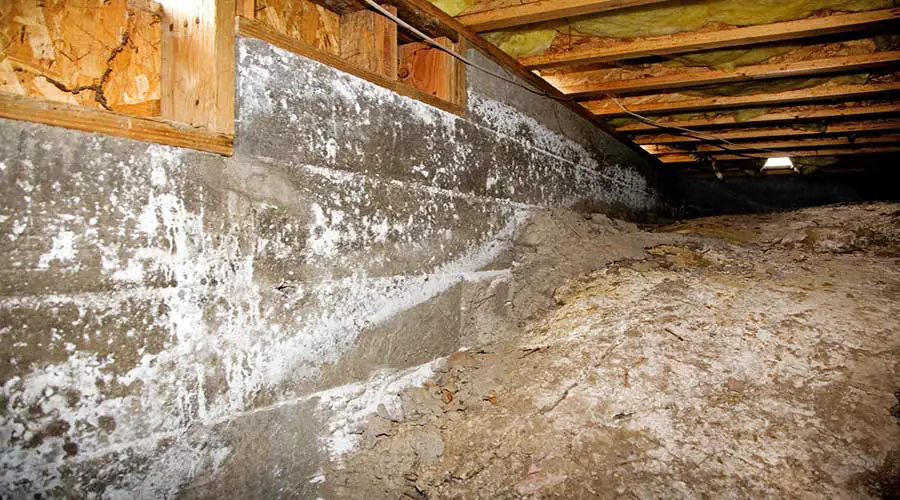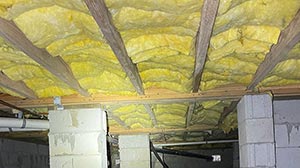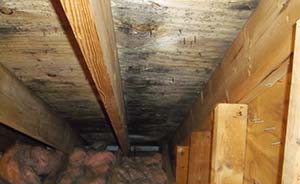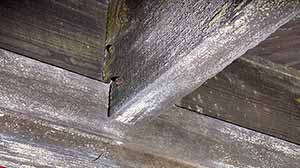
If you’ve found mold in your crawlspace, you must get rid of it immediately because it can be dangerous. But hopefully, you haven’t reached that stage yet, and you’re just looking to do some home maintenance.
It is vital to stop mold from forming in crawl spaces because it can contaminate the air and spread throughout your home. The best way to prevent mold is to keep everything well-ventilated and dry. Repair any water leaks, improve ventilation, and consider using a dehumidifier to reduce humidity.
Controlling mold inside crawl spaces is no simple task, but you must inspect and control mold as part of your spring or fall home maintenance. If your crawl space shows signs of mold, it can be dangerous for your home’s structural integrity and your family’s health.
How to Spot and Control Mold In Crawl Spaces
If you can smell something musty around your crawl space or someone in your home is experiencing allergic reactions, you might have a mold problem. And, if your baseboards near your crawl space are moldy or anything around your crawlspace is discolored, that’s where it’s coming from, and you need to inspect it.
Common signs you may have mold in your home or crawl spaces:
- An earthy or musty odor
- A sudden allergic reaction
- Green or brown material discoloration
- Peeling or warping material
- A water leak in a dark space
If you notice that you might have a mold problem, you can’t just open it up, climb in, and have a look. You have to put safety first. Before you inspect and while you’re down there, you must wear protective gear like disposable coveralls, a respirator or face mask, non-vented goggles, and heavy gloves.
Again, mold is damaging to your health, and if spores get to your lungs, it can have profound health implications. But that’s the reason that you’re here in the first place. So, once you’ve gotten into your safety gear, it’s time to inspect and control any mold in your home’s crawl spaces.
1. Redirect Gutters & Downspouts
You can start your inspection outside by checking your house’s gutters and downspouts. You need to make sure that they are diverting water away from the foundation. Rainwater can seep through to your crawlspace or basement after accumulating near your foundation. And once you have water in your crawl space, you’re in trouble.
2. Fix Cracks In Below-Ground Walls
If there are cracks in the walls around your crawlspace, this can be problematic and means that any water from other parts of the house has an entry point. You also need to look for cracks in the crawl space ceiling and your foundation. Get some poly filler and fix all the damages you can find, no matter how big or small.
3. Look For Leaks
Again, water is the enemy here. Most crawlspaces will have some pipes or plumbing components, such as HVAC ducts, and there may be a leak in a part of your house that you rarely see and just haven’t noticed. If you find any leaks, contact a plumber and fix them immediately because it’s a far less significant expense than the consequences of failing to do so.
4. Improve Ventilation
Mold thrives in poorly ventilated spaces. Preventing mold from accumulating in your crawl space can be made far easier by installing an extractor fan or another ventilation system to maintain airflow and get any unwanted moisture out of the area.
5. Improve Insulation
If you insulate the walls and floor of your crawl space with plastic sheeting, you can prevent any unwanted moisture from coming from the ground. Ensure all humidity problems are fixed before doing this because you can make the issue worse if your newly installed insulation traps a high moisture level inside.
6. Consider a Dehumidifier
Installing a dehumidifier in your crawl space is probably the best thing you can do because mold begins to thrive if humidity levels go beyond 60%. A crawl space dehumidifier will help to reduce and stabilize the humidity levels.
It’s best to inspect your crawl space to ensure it’s dry. Even the slightest bit of mold is a problem. It spreads quickly, and your crawl space is the perfect breeding ground for it.
How Mold Gets Into Your Crawl Space and What It Means
So, perhaps you have found a bit of mold on floor joists in your crawl space, and now you want to avoid making the same mistake again. And, if you’re freaking out, relax. As long as you’ve caught it early, you’ll be fine.
Mold is pervasive in buildings and places with a lot of moisture. It is found indoors and outdoors, entering your home through doorways, windows, and vents. When mold spores drop on any place with excess moisture, they grow, and many building materials provide all kinds of nutrients that encourage mold growth.
However, the problem with mold in your crawl space is that it is so close to your foundation, and the consequences of it getting out of hand can be devastating. You could lose entire rooms of your house or get seriously injured, over and above the respiratory issues, it causes.
Mold loves crawl spaces, and it happens to the best of us. It just means there has been a moisture buildup in the area. You now have to find a way to get rid of the mold and prevent it from happening again.
Now that you’ve done an adequate inspection and have our tips for controlling mold inside crawl spaces, you can identify and fix the problem. And then you can get to removing the mold.
How To Get Rid Of Mold In Your Crawl Space
If the job looks too big for you to handle yourself, you need to contact a mold remediation company. You may consider yourself a handy person, but the commercially available products may not be enough to do the job, and it’s just not worth the risk of trying to get rid of vast amounts of mold by yourself.
Hiring a specialist to remove mold from crawl spaces could cost anywhere between $1,500 and $4,000, even more, if there are damages to the house’s structural integrity. But you can’t put a price on your health, and if the mold spreads, the costs will be far, far higher, so it’s better to invest now.
However, it is possible to do DIY mold removal. But don’t forget to wear protective gear! Here is the basic process for removing mold from a crawl space:
- Spray the mold with a mold removal foaming spray
- Let it sit and loosen the mold
- Soak the mold in a mold killer
- Use a bristle brush to scrub off any mold
- Place all gear and equipment in a plastic bag
- Seal the bag and dispose of it
Start by spraying the mold-infected areas with a mold removal foaming spray. It will expand and helps to loosen the mold as you get ready to start cleaning.
Then, soak the mold with a mold killer and scrub off the residue with a stiff bristle brush. This process is time-consuming, but you want to brush off as much residue as possible because anything left behind will just spread, and you’ll end up with the same problem in a few weeks.
Once you’re done, take all your equipment, protective gear, and anything else that’s been contaminated and place it in a plastic bag. Safely dispose of the plastic bag. Do not leave your contaminated gear in the house!
Conclusion
Mold is dangerous and can turn your house into a disaster zone. And crawl spaces are always going to be a challenge when it comes to preventing the buildup of mold in a very awkward part of your house. But there are so many steps that you can take to ensure that your crawlspace receives adequate airflow, doesn’t get too humid, and is free of leaks.
Unfortunately, getting rid of mold is a complicated and expensive job. At that cost, it almost feels like it’s something you can put off and that you need to spend your money elsewhere. But don’t be fooled.
You need to get rid of that mold today! The problem only worsens, and when it gets bad, it can literally tear your house apart. Just remember that your number one priority needs to be your and anyone around you’s safety throughout the entire process.







